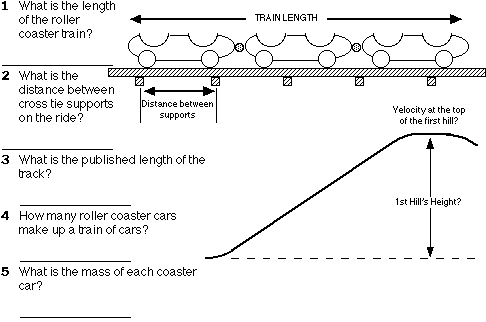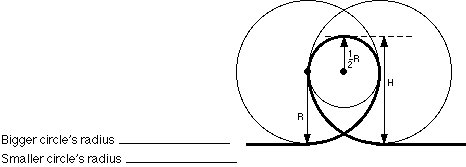
Neatness counts! If your work
can not be clearly read and understood then it is of no value. Be
meticulous.
Show your work and make comments as to what the distance and time
physically measures.

- You may get help from your notes, your text book,
handouts or any other group members.
- YOU MAY NOT GET HELP FROM ANOTHER TEACHER.
- This is due the Wednesday after the trip.

6 What is the vertical height of the
1st hill that the roller coaster car is lifted up?

7 How fast is the car traveling over
the top of the hill?

8 How much time does it take for the
middle of the train to reach the highest point of the first hill?

9 What is the velocity of the train at
the bottom of the dip after the first hill?

10 Using the velocity in the previous
question calculate the height of this drop.

If the coaster has a loop, answer questions
11-16.
11 What is the velocity of the roller coaster at the bottom of
the 1st loop?

12 What is the velocity of the roller
coaster at the top of the loop?

13 Using the information from the
previous questions, calculate the vertical height of the loop.

14 Suppose your loop was designed using
simple geometry. Below is an irregular loop shape that is designed
from the splicing together of two large circles with a smaller
circle. The smaller circle's radius is half the larger circle's
radius. Using the information from the previous problem calculate the
radii of the two circles.

15 Using the calculated radius
information above, calculate the g's felt by a rider at the bottom of
the loop and at the top of the loop.

16 Using your previous answers do you
think it is possible that the loop is designed according to our
simple geometry model?

17 Calculate the velocity of the car as
it travels over the 2nd hill.

18 Calculate the velocity of the car as
it travels past the bottom of the next dip.

19 Calculate the velocity of the car as
it travels over the 3rd hill.

20 Calculate the velocity of the car as
it travels past the bottom of the next dip.

21 Assuming the initial total
mechanical energy of the train is ZERO, how much total mechanical
energy is gained by raising the train of cars to the top of the first
hill.

22 The train has to lose its total
mechanical energy by the time it reaches the end of the ride.
Assuming 2/3's of this initial energy at the top of the hill is lost
due to friction during the length of the entire ride, what is
the average force of friction opposing the train's motion as it
travels along the entire length of the track? (HINT: Use
energy and work)

23 How much horsepower was used to
raise the train up the first hill?

24 If electricity costs $0.20/(kWhr), then how much does it cost to raise the
train up the first hill?

25 How many runs does a train make in 1
hour?

26 How much does it cost to run the
train in a 14 hour day?

If you use or find this page useful or have any
comments, please contact the author so maybe he'll do more.
Author: Tony Wayne
"ROLLER COASTER PHYSICS" TABLE
OF CONTENTS ... PHYSICS PAVILION TABLE OF
CONTENTS
<--PREVIOUS
SECTION ... NEXT SECTION
-->